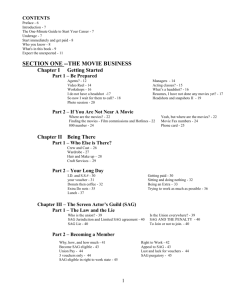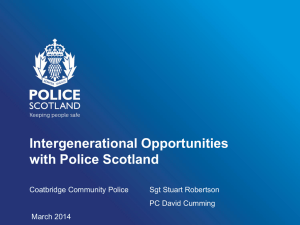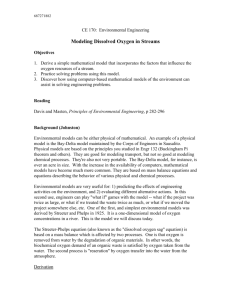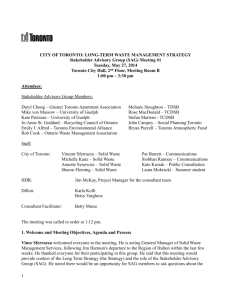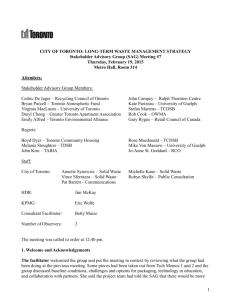SAG
advertisement
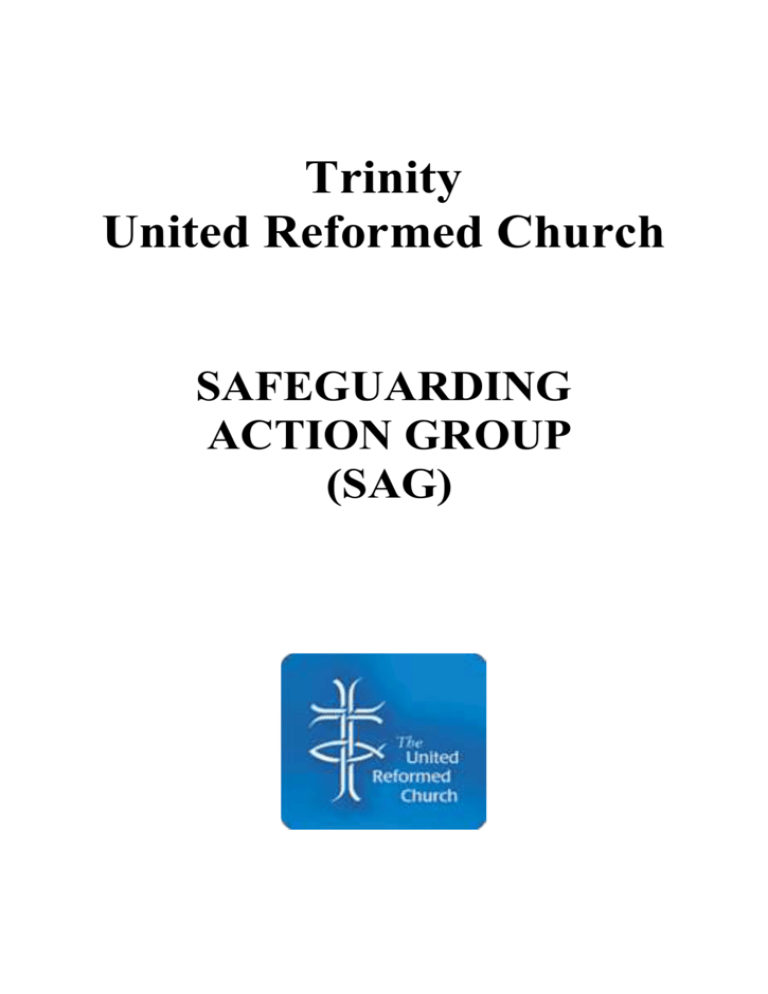
Trinity United Reformed Church SAFEGUARDING ACTION GROUP (SAG) lndex Page 1. Records of SAG Meetings 2. Names and contacts details of SAG committee members 3. Training 4 - 6. The Policy 7. Risk Assessment 8. Flow Chart for internal ‘possible’ child abuse 9. Flow Chart for complaints of ‘possible’ child abuse 10. Child Protection Incident Record Form 11. Overview of the Vulnerable Adult Protection Process 12. Guidance for Alerters 13-14. Adult protection Alert Form 15-16. Description of Elders responsibilities 17. Contact names and contact details of relevant Agencies, e.g. Police, Social Services 18-21. Appendix: Types of Abuse Application form RECORDS OF SAG MEETINGS including Annual Review of SAG Policy and Procedures DATE 19/10/14 Members Present Dawn, Marilyn, Kathy S, John, Kathy C, Margaret, Jack B, Jack S, Elizabeth 08/03/15 Dawn, Margaret, Paul, Kathy S Action to be taken 1.Agreed doc, team and contacts 2.KS to arrange Training 3.KS to update this Document. 4. KS to update/place Policy in Church 5.KS/DM to raise DBS to replace the current Children CRBs when renewed Oct’ 2015 Doc reviewed Ok. 1.DM to raise Ref’s @ E/mtg 2.KS to send tr dates to PT/KC 3. DM to speak to MG re DBS 4. KS to change tel nos –done 5. KS, put copy of doc in church Pg. 1 Names and Contact Details of SAG Committee Members Revd. Dawn Mather (01624) 629202 Mrs Kathy Shimmin (01624) 815759 Mrs Margaret Nowak (01624) 402013 Paul Taylor (01624) 422104 Email : kathyshimmin@manx.net This group reports to the eldership of Trinity URC Any contact you make with SAG will be actioned in accordance with the policy and procedures outlined in the following documents. Trinity’s office holders will be submitting two references, in accordance with the policy and procedures and will have completed a Disclosure and Barring Service (DBS) check where necessary. This group will meet 6 monthly. Pg. 2 Training Name Course Attended Rev Dawn Mather Safeguarding Children 23rd July 2013 Updating Policy training. Protecting children Board IOM Vulnerable Adult Training 15th Apr 2015 26th Jan 2013 Safe Environment 23rd Feb 2013 First Aider 22nd Jan 2015 Child Protection IOM 15th Apr 2015 Kathy Shimmin Margaret Nowak Date of Course Vulnerable Adult Training Child Protection IOM Vulnerable Adult Training 22nd Jan 2015 15th Apr 2015 Child Protection IOM Vulnerable Adult training Vulnerable Adult Training 22nd Jan 2015 15th Apr 2015 15th Apr 2015 Paul Taylor Marilyn Gould John Shimmin Aline Cannell Elizabeth Bedward Kathy Carter Jack Brown Jack Smith Rod MacLeod Now retired Pg. 3 Policy and Procedures 1. Trinity Church acknowledges its responsibility to protect and safeguard every child and young person who has been intrusted to its care and is committed to working to provide a safe environment for all members. A child or young person is anyone under the age of 18. We subscribe to the “PCB lnter Agency Child Protection Procedures” (Protecting Children Board lOM) and endorse and adopt the procedural guidance contained in that document. 2. The Key Principles are that: The child’s safety is, and must always be, the paramount consideration All children and young people have a right to be protected from abuse regardless of their age, gender, disability, race, sexual orientation, faith or belief. All suspicions and allegations of abuse will be taken seriously and responded to swiftly and appropriately Working in partnership with all other organisations, children and young people and their parents/carers is essential. We acknowledge that every child and young person who participates in our church should be able to take part in an enjoyable and safe environment and be protected from poor practice and abuse. Trinity recognises that this is the responsibility of every adult within our church. 3. Trinity Church has a role to play in protecting all children and young people by protecting them from physical, sexual or emotional harm and from neglect or bullying. It is noted and accepted that the PCB principles apply to everyone in the church whether in a paid or voluntary capacity. Pg. 4 4. We endorse and adopt the PCB safer recruitment standards when recruiting volunteers and we will: Specify what the role is and what task it involves As a minimum meet and chat with applicants Ask for and follow up with 2 references before appointment Require a Police check or DBS check where appropriate in line with PCB guidelines \ All current officers of the church who regularly supervise children and young people will be required to complete an enhanced DBS. lf there are concerns regarding the appropriateness of an individual who is already involved or who has approached us to become involved in children's work, guidance will be sought from SAG. lt is noted and accepted that Trinity elders will consider the relevance and significance of the information obtained via the DBS check and that all decisions will be made SAG in the best interests of protecting children and young people, on the basis of safer recruitment best practice and contained within their policy and procedures. lt is accepted that the aim is to prevent people with a history of relevant and significant offending from having contact with children or young people and the opportunity to have direct and unsupervised contact. This is to prevent direct sexual or physical harm to children and minimise the risk of grooming. 5. Trinity supports the IOM whistle Blowing Policy. Any adult or young person with concerns about a member can contact SAG or alternatively by going direct to the Police, Children's Social Care or the NSPCC. Pg. 5 6. Trinity has appointed a committee whose members have and will continue to attend training sessions provided by the PCB. Members of SAG are the first point of contact for all church members with any child related concerns. They will play an active role in increasing awareness of poor practice, of the need for respect, and the knowledge of signs of abuse. 7. We acknowledge and endorse the identification of bullying as a category of abuse. Bullying of any kind is not acceptable in Trinity Church. If it occurs contact SAG members immediately. Safeguarding is everyone’s responsibility. lf you are worried about a child it is important that you report your concerns NO ACTION IS NOT AN OPTION! > If worried about a child report your concern to SAG > If the issue is poor practice and your concerns are not taken seriously please contact SAG for further advice > If concern is serious — possible child abuse, then immediately contact SAG > If a child needs immediate medical care please take them to a hospital informing parents. And if this is a child protection concern inform SAG > If you cannot contact SAG or the matter is clearly serious please contact the Police or Children's Social Care (Contact numbers on page 13 of this folder) Pg. 6 TRINITY URC RISK ASSESSMENT CHILDRENS ACTIVITIES Church Building Hazards Outcomes Actions Hall doors Unidentified People entering the building Missing child The doors cannot be locked due to fire precautions. As these doors are visible , they are supervised by the staff Hall Stacked chairs Falls Stacked to accepted heights Power sockets Electric shocks All out of reach of small children, and covers on unused sockets Cleaning materials Poisoning Kept in locked cupboards and key is hidden out of reach of children. Climbing Falls Hot water from taps and urn Burns and scalds Children are supervised when on the stage, and are not allowed to jump off the stage No hot water is freely available and the equipment has to be switched on. No children are allowed into the kitchen unless an adult is present. Stage Kitchen Burns Oven Toilets Low hazard as no hot water is available No action required N.B. Guides and Brownie Leaders have carried out their own assessments and have completed their ‘Safe Environment’ and ‘ First Aid’ training. All Children are collected by a parent or known adult. Pg. 7 CHILD PROTECTION FLOW CHART WHAT TO DO IF YOU HAVE ANY CONCERNS ABOUT POSSIBLE CHILD ABUSE WITHIN TRINITY Are you concerned about the behaviour of someone with our church community? Could this be child abuse ? Report concerns to Safeguarding Action Group (SAG) who will ensure immediate safety of the child and other children present. The SAG group will then access and refer to Social Services (who may involve the police) lf the allegation concerns a member of SAG, contact an Elder of the Church who will make the referral to the Social Services or the police. Possible Outcomes: Police/Social Services enquiry-Criminal proceedings Referral back to SAG — Church sanctions imposed No case to answer Pg. 8 CHILD PROTECTION FLOW CHART WHAT STEPS NEED TO BE TAKEN WHEN REPORTING CONCERNS When the complaint is about possible child abuse Outside of Trinity’s Premises Report to Designated Group SAG Decide if reasonable grounds for concerns. Refer to Key Principles for guidance. Unclear SAG designated person should consult with duty officer at Social Services and obtain advice. The discussion should be recorded by both parties in a retrievable format. No case to answer Make a formal referral to Social Services Tell Complainant Discuss with Social Services/Police how parent/guardian will be . informed Consider – is the parent the alleged abuser Tell parent after advise from Social Services lf in doubt or you do not know who to turn to for advice or are worried about sharing your concerns please contact Social Services or read the PCB inter agency child protection procedures or ‘What to do worried a child is being abused or at risk of abuse’ guidance document available on the PCB’s website. Pg. 9 CHILD PROTECTION Pg. 10 VULNERABLE ADULTS FLOWCHART Pg.11 VULNERABLE ADULTS FLOWCHART Pg.12 VULNERABLE ADULTS ALERT FORM Pg.13 VULNERABLE ADULTS ALERT FORM cont’d Pg. 14 Description of Elders Responsibilities lntroduction The elders are an elected body, ordained for life with pastoral responsibilities towards members of the congregations. Elders work alongside the minister of word and sacrament in leading the church. Although the elders are a leadership body the decision making lies in the church meeting. The elders meeting is there for the discussion of work within the church and our discussions are a means by which we discern the will of God for the future. The elders meeting relies on the skills of each individual member who take responsibility for various aspects of church life, leading Action Groups on such areas as management of buildings, pastoral care, hospitality, policies and procedures, worship, finances, children’s work, mission and support of the minister. An elder must be: Of good character Established within the church as a church member Voted into position by the church meeting Honest, trustworthy and committed With a heart for the care of other Must be prepared to accept training Have an understanding for current URC Policies and Procedures For protection of Children and Vulnerable Adults, the elders have submitted to the following pathway: 1. Completed enhanced DBS check, where necessary 2. Two references - to be held by the minister 3. Training for work with children and vulnerable adults Pg. 15 The responsibilities for pastoral care are taken seriously by the elders. We encourage the members of the congregation, to take responsibility of sharing with the elders and minister, any and all concerns within the church. This enables us to find the relevant person or group who may help. Pg. 16 Contact Details for SAG Social Services: Tel: 01624 – 686179 The address is as follows: Children & Families Division 2nd floor Murray House Mount Havelock Douglas Isle of Man IM1 2SF The Police Numbers are: The Public Protection Unit During office hours the number is 01624 - 631493 Outside of office hours - Police Headquarters, 01624 - 631212 where the call will be transferred to either a Duty Detective or duty Sergeant Pg. 17 APPENDIX Types of Abuse Sexual: Actual or likely sexual exploitation of a child or adolescent. Emotional: Actual or likely severe adverse effect on the emotional and behavioural development of a child caused by persistent or severe emotional treatment or rejection. All abuse involves some emotional ill treatment. This category is used where it is the main or sole from of abuse. Neglect: The persistent or severe neglect of a child or the failure to protect a child from exposure to any kind of danger, including cold and starvation or extreme failure to carry out important aspects of care, resulting in the significant impairment of a child’s health or development, including non- organic failure to thrive. The following may be signs of abuse NB : Physical abuse and neglect are difficult to hide. Sexual abuse can be almost impossible to identify and prove. Many symptoms of distress can point to abuse but there may be other explanations. it is important therefore, that the below signs are not taken as indications that abuse has taken place. They should make us stop and think, but not necessarily to jump to conclusions. Physical: Unexplained injuries or those which have no medical attention, hidden in juries, shrinking away from unexpected arm movements. Sexual: allegations made by the child or young person, preoccupation with sexual matters, sexual activity through words, play or drawings, severe sleep disturbances with fears and phobias, being sexually provocative with adults. Pg. 18 Emotional: regression in behaviour, nervousness, sudden underachievement, inappropriate relationships with peers/adults, attention seeking, running away/stealing/lying, looking uncared-for Neglect: scavenging for food, unkempt clothing, listlessness, underweight, poor hygiene. Pg. 19 Pg. 20 Pg. 21


